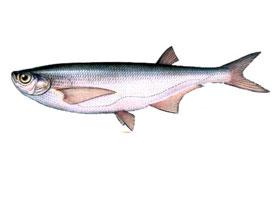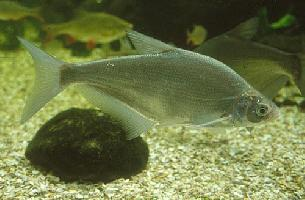
Váhy a míry
| Délka | 30 cm |
|---|---|
| Hmotnost | od 0,1 do 0,3 kg |
Stav ohrožení
| Ohrožen |
Popis zvířete
The Common Rudd (Scardinius erythrophthalmus) is a captivating freshwater fish, widely recognized for its vibrant appearance and dynamic behavior. Belonging to the Cyprinidae family, which is notably one of the largest fish families, this species is prevalent across Europe and parts of Asia, thriving in lakes, ponds, canals, and slow-flowing rivers. The common rudd's adaptability to various aquatic environments, alongside its appealing aesthetics, has also made it a favored species among aquarium enthusiasts and anglers.Physically, the Common Rudd exhibits a somewhat deep, laterally compressed body that is typically covered in shimmering scales, casting a silvery reflection that is beautifully complemented by subtle golden hues. One of the most striking features of this species is its vivid red fins, especially the pelvic and anal fins, which contrast starkly against the more subdued tones of its body. The dorsal fin is positioned towards the back half of the body and is slightly rounded, contributing to its streamlined shape for efficient swimming. Adult specimens can reach lengths of up to 45-50 cm (18-20 inches), although sizes around 20-25 cm (8-10 inches) are more common.
The Common Rudd's eyes are another distinctive attribute, characterized by their large size and the brilliant red coloration that mirrors the vividness of its fins. This feature not only adds to the fish's visual appeal but also enhances its vision in low-light conditions, facilitating effective foraging during dawn and dusk.
Diet-wise, the Common Rudd is omnivorous, displaying a versatile feeding behavior. It primarily consumes aquatic vegetation, algae, insects, and small invertebrates. Its upturned mouth is a specialized adaptation that enables the efficient consumption of surface-floating food items, reflecting its preference for feeding at or near the water's surface.
Reproduction occurs in the spring and early summer when water temperatures rise. Females release thousands of eggs in shallow, vegetated areas of water bodies, where males then fertilize them. The survival of juveniles significantly depends on the availability of shelter and food, conditions that are ideally met in environments with abundant aquatic vegetation.
The Common Rudd is not only of interest for its beauty and ecological role in freshwater habitats but also for its significance in recreational fishing. It is highly regarded by anglers for its spirited fight when hooked, making it a challenging and rewarding catch. Despite its popularity, the species faces threats from habitat degradation, pollution, and competition with invasive species, emphasizing the need for conservation efforts to ensure its sustainability in natural habitats.
In summary, the Common Rudd (Scardinius erythrophthalmus) is a remarkable freshwater fish that captivates observers with its striking red fins and adaptable nature. Its presence enriches aquatic ecosystems, offering a glimpse into the complex interplay of life in freshwater environments. Whether seen gliding through the clear waters of a tranquil pond or thriving in the diverse community of a bustling aquarium, the Common Rudd remains a testament to the beauty and resilience of freshwater fauna.
Podobná zvířata
Nové fotografie zvířat
Top 10 zvířat
- Dolphin gull (Leucophaeus scoresbii)
- Diana monkey (Cercopithecus diana)
- Moustached guenon (Cercopithecus cephus)
- Galápagos tortoise (Geochelone nigra complex)
- Japanese macaque (Macaca fuscata)
- Stone loach (Barbatula barbatula)
- Russian tortoise (Testudo horsfieldii)
- Greek tortoise (Testudo graeca)
- Common flying dragon (Draco volans)
- Vendace (Coregonus albula)


